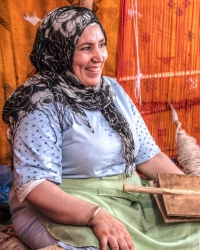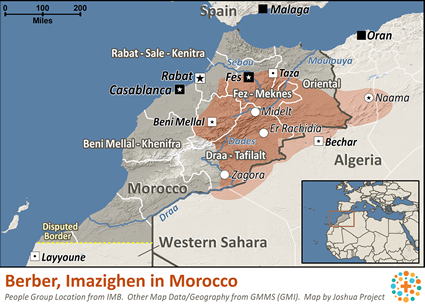There are a number of tribes in Morocco who some say have been there since the stone age. They were first mentioned by the ancient Egyptians. Though they all identify with the name of their own tribe, their Roman conquerors gave them the collective name of “Berber” or barbarian. They prefer the term “Imazighen” which means “free men.” They were more likely to take on this collective term when North Africa was conquered by the Muslim Arabs in the 800s. This was their way to differentiate themselves from the powerful Arabs.
Most Imazighen peoples have a specific tribe of identity. Those who don't, we will call Imazighen Berber. They speak Central Atlas Tamazight.
The Imazighen Berbers primarily raise sheep and goats, although they also have other domestic animals. Most have a few mules and donkeys which are used for transport. In the mountains, raising animals is economically more important than farming. The dominant feature of Imazighen Berber life is transhumance. This means that they transfer their livestock from one grazing ground to another, alternating from the highlands to the lowlands with the changing of seasons.
The Imazighen Berber move their herds to the warm plains during the winter months, then to higher pastures during the spring and summer months. Depending on their locations in the mountains, some only have to move their herds during the winter. Others only migrate during the summer. A third group moves the herds during the winter and the summer.
Although often on the move, none of the Imazighen Berber tribes are totally nomadic. All of them maintain permanent villages with fortified, community granaries and surrounding farmlands. The villages are never left unattended. A small number of people stay behind to guard the granaries and to plant crops such as barley, maize, wheat, rye, millet and vegetables. Very few of their villages have electricity or running water, but most have their own internal means of communication.
It is common for three or four generations to live in the same dwelling. All family members acknowledge a common male ancestor. As members of the family, they are entitled to certain rights and privileges concerning the family heritage. The family structure is somewhat of an authoritarian democracy. While the head of the family is responsible for controlling and administering all household matters, he must come to an agreement with the rest of the family. Banishment from the family is considered the ultimate punishment.
The Imazighen Berbers are virtually all Muslim; however, their religious practices are based more on traditions and the decisions of the community judges than on the Koran. Their societies are organized around two main systems: Islam and the tribe. However, there are many differences between urban and rural societies. In urban areas, orthodox Islam prevails; whereas, in rural societies, ancient beliefs and customs are intermingled with their Muslim faith.
Most of Imazighen Berbers have continued in their traditional worship of saints. One group of spiritual leaders called marabouts are considered "living saints." They are believed to possess healing abilities and supernatural powers. Each of the villages reveres one or more of these "saints."
In the eighth century, invading Arabs forced the Imazighen Berbers to accept Islam. Prior to that time, many of them were Christians. Today, there are a number of Imazighen Berber believers in Morocco.
Pray for God to anoint the gospel as it goes forth via radio.
Ask the Lord to encourage and protect Imazighen Berbers believers in Morocco.
Ask God to call forth prayer teams who will begin breaking up the soil through worship and intercession.
Pray that strong local churches that will plant more Imazighen Berbers churches.
Scripture Prayers for the Berber, Tamazight in Morocco.
https://www.journeybeyondtravel.com/blog/morocco-travel-berbers.html
https://en.wikipedia.org/wiki/Berbers
https://en.wikipedia.org/wiki/Traditional_Berber_religion
| Profile Source: Joshua Project |


























